An Application of Multivariate GARCH Model: Nigeria's Money Market
VerifiedAdded on 2022/12/19
|49
|9506
|1
Report
AI Summary
This report delves into the complex relationship between money market rates and exchange rates in Nigeria, employing a multivariate GARCH model to analyze their dynamics. The study investigates the volatility of interbank money market interest rates and their effects on the exchange rate, examining the channels through which these factors influence each other. The research covers a period of over 40 years, from the pre-flexible exchange rate era to the present, to assess the fluctuations and volatility in exchange rates. The report aims to explain the causes of the depreciation of the Nigerian Naira against major currencies, considering factors like the decline in crude oil prices and the strength of the money market. The objectives include examining the direction of inter-bank money market interest rate volatility and its effects on exchange rate in Nigeria, determination of channel of transmission through which the volatility in inert-bank money market interest rate and exchange rate are affected in the country, and evaluation of the changes in foreign exchange rates in the country with the help of GARCH model. The findings and recommendations provide valuable insights for understanding and managing the economic challenges faced by Nigeria. The report includes a detailed review of related literature, a discussion of the methodology, and an analysis of the descriptive and empirical results, including correlation, causality, and unit root analyses, alongside model estimation and hypothesis testing.
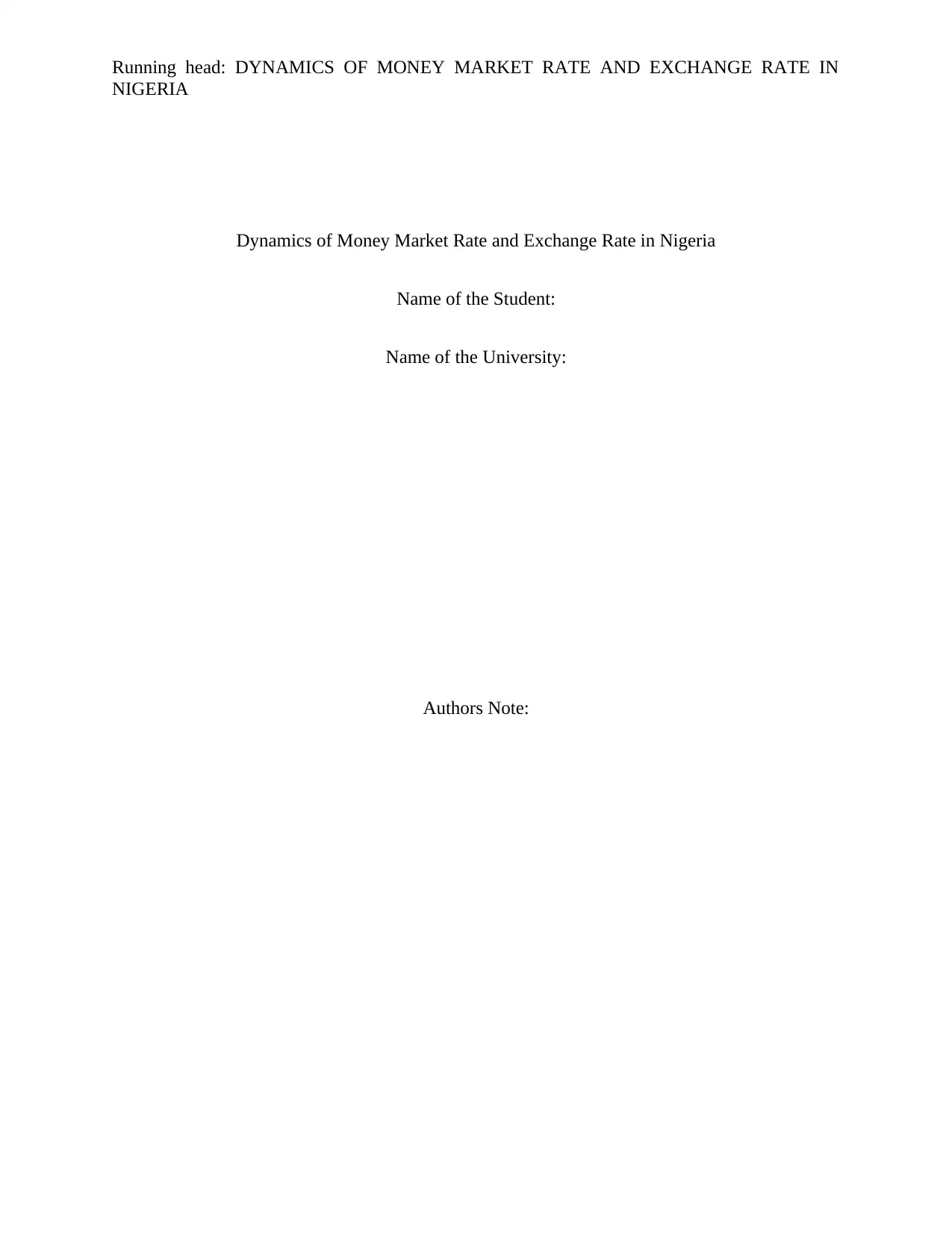
Running head: DYNAMICS OF MONEY MARKET RATE AND EXCHANGE RATE IN
NIGERIA
Dynamics of Money Market Rate and Exchange Rate in Nigeria
Name of the Student:
Name of the University:
Authors Note:
NIGERIA
Dynamics of Money Market Rate and Exchange Rate in Nigeria
Name of the Student:
Name of the University:
Authors Note:
Paraphrase This Document
Need a fresh take? Get an instant paraphrase of this document with our AI Paraphraser
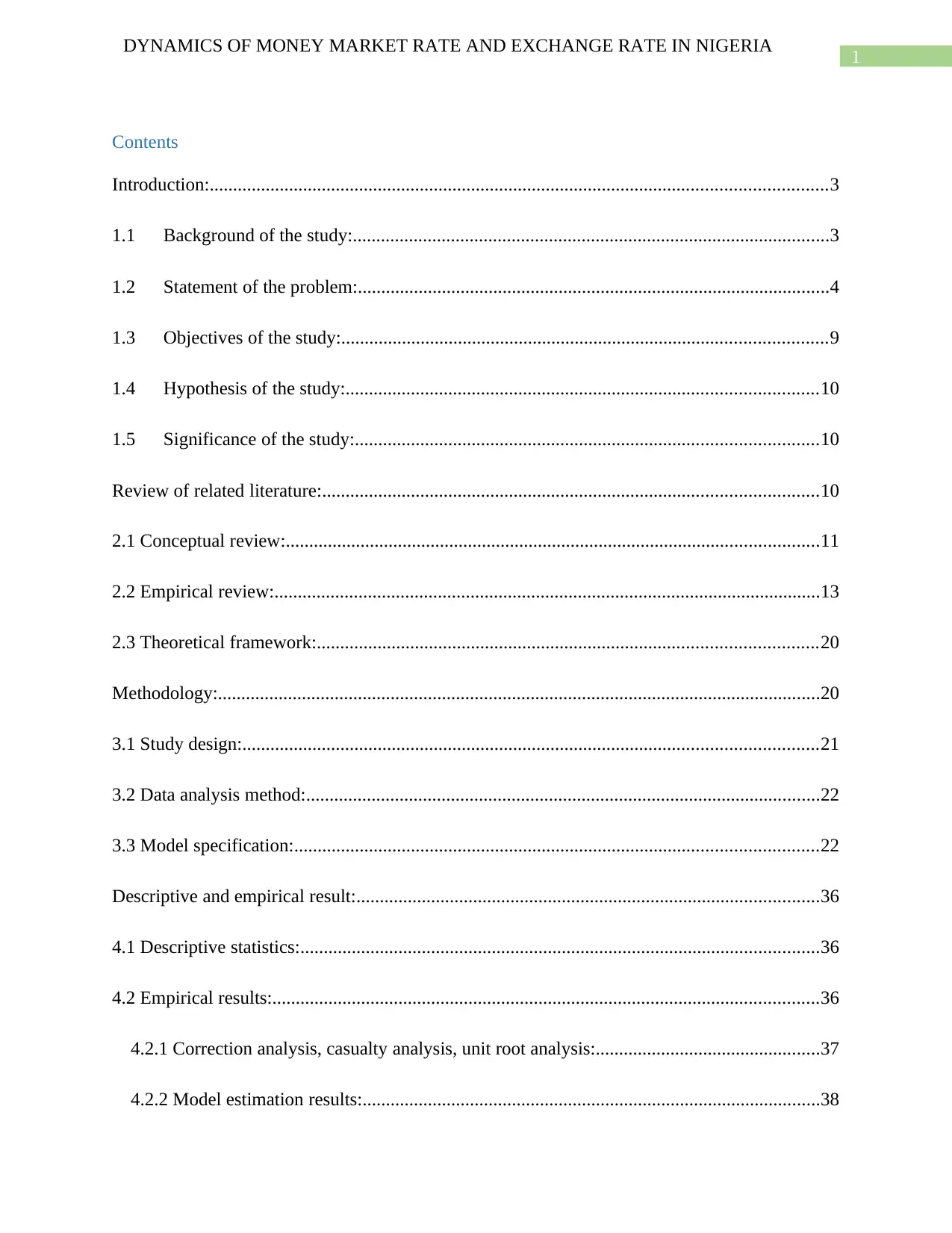
1
DYNAMICS OF MONEY MARKET RATE AND EXCHANGE RATE IN NIGERIA
Contents
Introduction:....................................................................................................................................3
1.1 Background of the study:......................................................................................................3
1.2 Statement of the problem:.....................................................................................................4
1.3 Objectives of the study:........................................................................................................9
1.4 Hypothesis of the study:.....................................................................................................10
1.5 Significance of the study:...................................................................................................10
Review of related literature:..........................................................................................................10
2.1 Conceptual review:..................................................................................................................11
2.2 Empirical review:.....................................................................................................................13
2.3 Theoretical framework:...........................................................................................................20
Methodology:.................................................................................................................................20
3.1 Study design:...........................................................................................................................21
3.2 Data analysis method:..............................................................................................................22
3.3 Model specification:................................................................................................................22
Descriptive and empirical result:...................................................................................................36
4.1 Descriptive statistics:...............................................................................................................36
4.2 Empirical results:.....................................................................................................................36
4.2.1 Correction analysis, casualty analysis, unit root analysis:................................................37
4.2.2 Model estimation results:..................................................................................................38
DYNAMICS OF MONEY MARKET RATE AND EXCHANGE RATE IN NIGERIA
Contents
Introduction:....................................................................................................................................3
1.1 Background of the study:......................................................................................................3
1.2 Statement of the problem:.....................................................................................................4
1.3 Objectives of the study:........................................................................................................9
1.4 Hypothesis of the study:.....................................................................................................10
1.5 Significance of the study:...................................................................................................10
Review of related literature:..........................................................................................................10
2.1 Conceptual review:..................................................................................................................11
2.2 Empirical review:.....................................................................................................................13
2.3 Theoretical framework:...........................................................................................................20
Methodology:.................................................................................................................................20
3.1 Study design:...........................................................................................................................21
3.2 Data analysis method:..............................................................................................................22
3.3 Model specification:................................................................................................................22
Descriptive and empirical result:...................................................................................................36
4.1 Descriptive statistics:...............................................................................................................36
4.2 Empirical results:.....................................................................................................................36
4.2.1 Correction analysis, casualty analysis, unit root analysis:................................................37
4.2.2 Model estimation results:..................................................................................................38
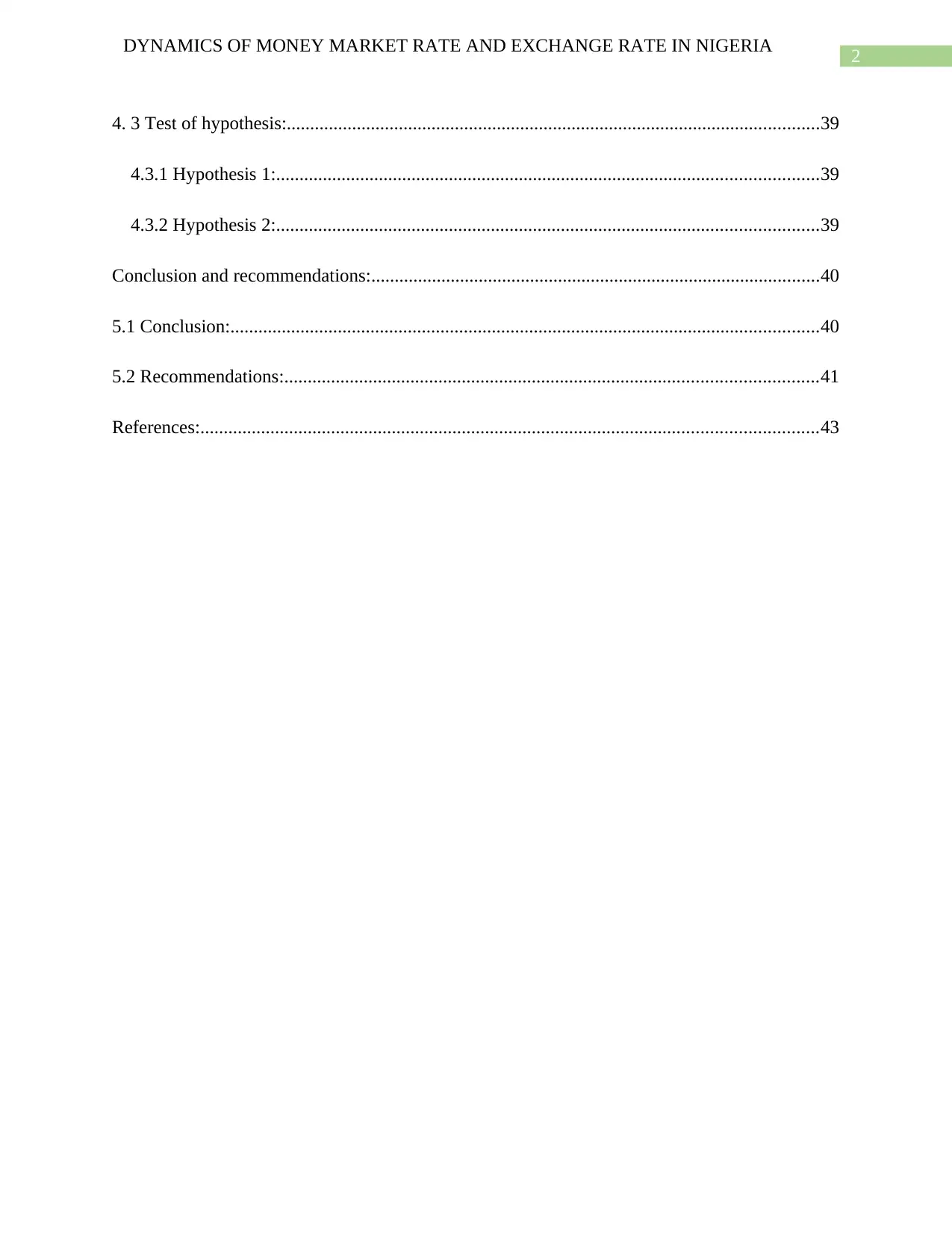
2
DYNAMICS OF MONEY MARKET RATE AND EXCHANGE RATE IN NIGERIA
4. 3 Test of hypothesis:..................................................................................................................39
4.3.1 Hypothesis 1:....................................................................................................................39
4.3.2 Hypothesis 2:....................................................................................................................39
Conclusion and recommendations:................................................................................................40
5.1 Conclusion:..............................................................................................................................40
5.2 Recommendations:..................................................................................................................41
References:....................................................................................................................................43
DYNAMICS OF MONEY MARKET RATE AND EXCHANGE RATE IN NIGERIA
4. 3 Test of hypothesis:..................................................................................................................39
4.3.1 Hypothesis 1:....................................................................................................................39
4.3.2 Hypothesis 2:....................................................................................................................39
Conclusion and recommendations:................................................................................................40
5.1 Conclusion:..............................................................................................................................40
5.2 Recommendations:..................................................................................................................41
References:....................................................................................................................................43
⊘ This is a preview!⊘
Do you want full access?
Subscribe today to unlock all pages.

Trusted by 1+ million students worldwide
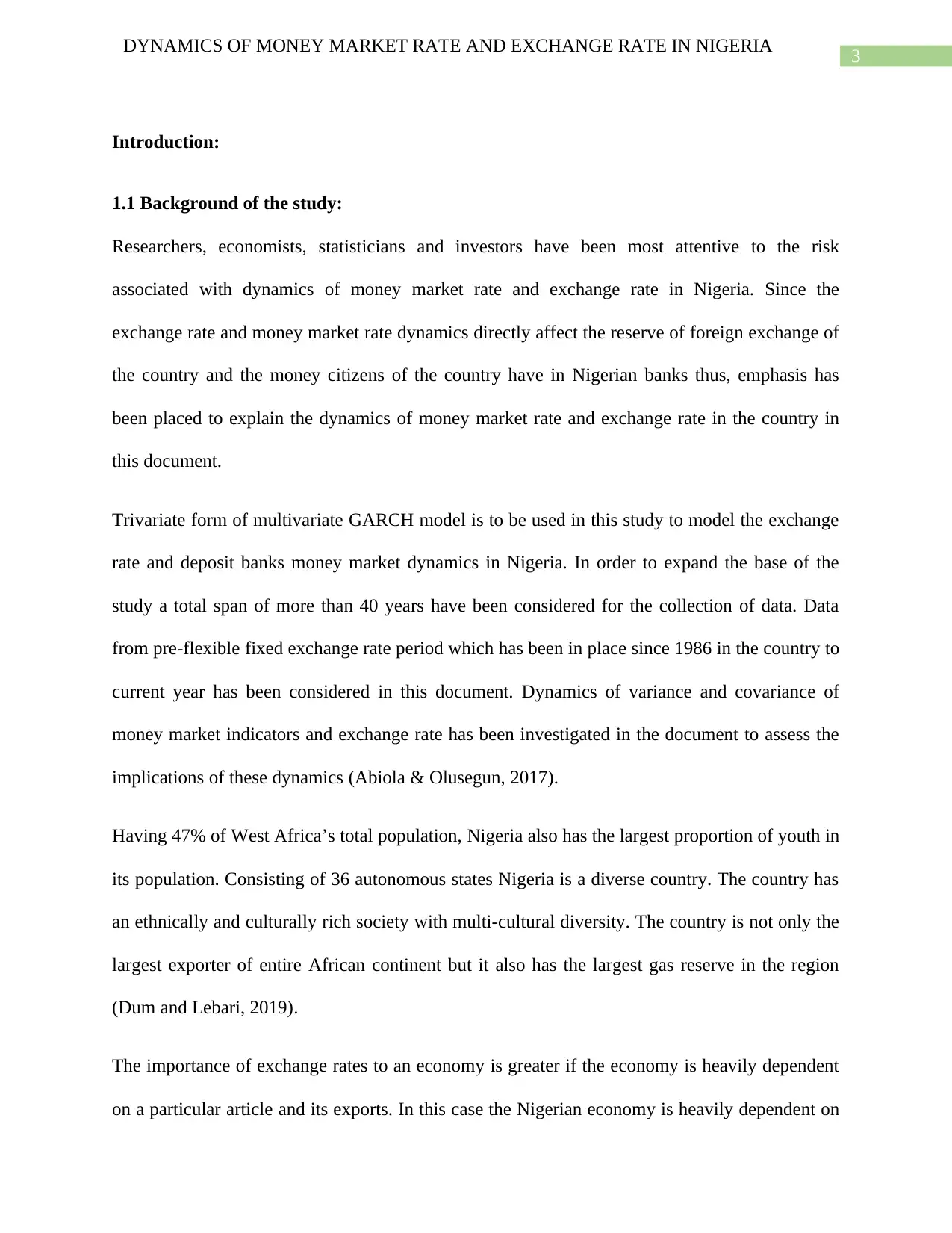
3
DYNAMICS OF MONEY MARKET RATE AND EXCHANGE RATE IN NIGERIA
Introduction:
1.1 Background of the study:
Researchers, economists, statisticians and investors have been most attentive to the risk
associated with dynamics of money market rate and exchange rate in Nigeria. Since the
exchange rate and money market rate dynamics directly affect the reserve of foreign exchange of
the country and the money citizens of the country have in Nigerian banks thus, emphasis has
been placed to explain the dynamics of money market rate and exchange rate in the country in
this document.
Trivariate form of multivariate GARCH model is to be used in this study to model the exchange
rate and deposit banks money market dynamics in Nigeria. In order to expand the base of the
study a total span of more than 40 years have been considered for the collection of data. Data
from pre-flexible fixed exchange rate period which has been in place since 1986 in the country to
current year has been considered in this document. Dynamics of variance and covariance of
money market indicators and exchange rate has been investigated in the document to assess the
implications of these dynamics (Abiola & Olusegun, 2017).
Having 47% of West Africa’s total population, Nigeria also has the largest proportion of youth in
its population. Consisting of 36 autonomous states Nigeria is a diverse country. The country has
an ethnically and culturally rich society with multi-cultural diversity. The country is not only the
largest exporter of entire African continent but it also has the largest gas reserve in the region
(Dum and Lebari, 2019).
The importance of exchange rates to an economy is greater if the economy is heavily dependent
on a particular article and its exports. In this case the Nigerian economy is heavily dependent on
DYNAMICS OF MONEY MARKET RATE AND EXCHANGE RATE IN NIGERIA
Introduction:
1.1 Background of the study:
Researchers, economists, statisticians and investors have been most attentive to the risk
associated with dynamics of money market rate and exchange rate in Nigeria. Since the
exchange rate and money market rate dynamics directly affect the reserve of foreign exchange of
the country and the money citizens of the country have in Nigerian banks thus, emphasis has
been placed to explain the dynamics of money market rate and exchange rate in the country in
this document.
Trivariate form of multivariate GARCH model is to be used in this study to model the exchange
rate and deposit banks money market dynamics in Nigeria. In order to expand the base of the
study a total span of more than 40 years have been considered for the collection of data. Data
from pre-flexible fixed exchange rate period which has been in place since 1986 in the country to
current year has been considered in this document. Dynamics of variance and covariance of
money market indicators and exchange rate has been investigated in the document to assess the
implications of these dynamics (Abiola & Olusegun, 2017).
Having 47% of West Africa’s total population, Nigeria also has the largest proportion of youth in
its population. Consisting of 36 autonomous states Nigeria is a diverse country. The country has
an ethnically and culturally rich society with multi-cultural diversity. The country is not only the
largest exporter of entire African continent but it also has the largest gas reserve in the region
(Dum and Lebari, 2019).
The importance of exchange rates to an economy is greater if the economy is heavily dependent
on a particular article and its exports. In this case the Nigerian economy is heavily dependent on
Paraphrase This Document
Need a fresh take? Get an instant paraphrase of this document with our AI Paraphraser
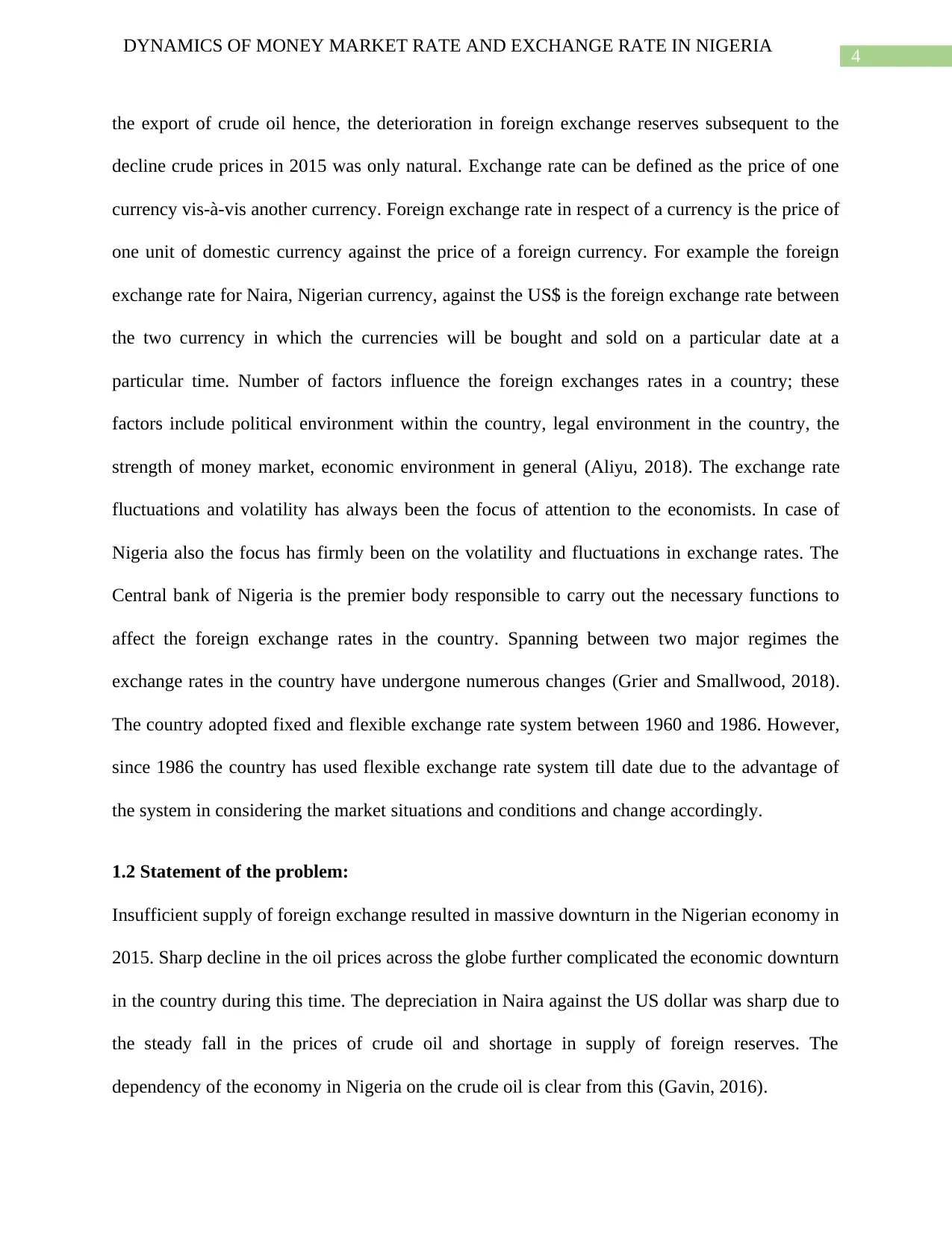
4
DYNAMICS OF MONEY MARKET RATE AND EXCHANGE RATE IN NIGERIA
the export of crude oil hence, the deterioration in foreign exchange reserves subsequent to the
decline crude prices in 2015 was only natural. Exchange rate can be defined as the price of one
currency vis-à-vis another currency. Foreign exchange rate in respect of a currency is the price of
one unit of domestic currency against the price of a foreign currency. For example the foreign
exchange rate for Naira, Nigerian currency, against the US$ is the foreign exchange rate between
the two currency in which the currencies will be bought and sold on a particular date at a
particular time. Number of factors influence the foreign exchanges rates in a country; these
factors include political environment within the country, legal environment in the country, the
strength of money market, economic environment in general (Aliyu, 2018). The exchange rate
fluctuations and volatility has always been the focus of attention to the economists. In case of
Nigeria also the focus has firmly been on the volatility and fluctuations in exchange rates. The
Central bank of Nigeria is the premier body responsible to carry out the necessary functions to
affect the foreign exchange rates in the country. Spanning between two major regimes the
exchange rates in the country have undergone numerous changes (Grier and Smallwood, 2018).
The country adopted fixed and flexible exchange rate system between 1960 and 1986. However,
since 1986 the country has used flexible exchange rate system till date due to the advantage of
the system in considering the market situations and conditions and change accordingly.
1.2 Statement of the problem:
Insufficient supply of foreign exchange resulted in massive downturn in the Nigerian economy in
2015. Sharp decline in the oil prices across the globe further complicated the economic downturn
in the country during this time. The depreciation in Naira against the US dollar was sharp due to
the steady fall in the prices of crude oil and shortage in supply of foreign reserves. The
dependency of the economy in Nigeria on the crude oil is clear from this (Gavin, 2016).
DYNAMICS OF MONEY MARKET RATE AND EXCHANGE RATE IN NIGERIA
the export of crude oil hence, the deterioration in foreign exchange reserves subsequent to the
decline crude prices in 2015 was only natural. Exchange rate can be defined as the price of one
currency vis-à-vis another currency. Foreign exchange rate in respect of a currency is the price of
one unit of domestic currency against the price of a foreign currency. For example the foreign
exchange rate for Naira, Nigerian currency, against the US$ is the foreign exchange rate between
the two currency in which the currencies will be bought and sold on a particular date at a
particular time. Number of factors influence the foreign exchanges rates in a country; these
factors include political environment within the country, legal environment in the country, the
strength of money market, economic environment in general (Aliyu, 2018). The exchange rate
fluctuations and volatility has always been the focus of attention to the economists. In case of
Nigeria also the focus has firmly been on the volatility and fluctuations in exchange rates. The
Central bank of Nigeria is the premier body responsible to carry out the necessary functions to
affect the foreign exchange rates in the country. Spanning between two major regimes the
exchange rates in the country have undergone numerous changes (Grier and Smallwood, 2018).
The country adopted fixed and flexible exchange rate system between 1960 and 1986. However,
since 1986 the country has used flexible exchange rate system till date due to the advantage of
the system in considering the market situations and conditions and change accordingly.
1.2 Statement of the problem:
Insufficient supply of foreign exchange resulted in massive downturn in the Nigerian economy in
2015. Sharp decline in the oil prices across the globe further complicated the economic downturn
in the country during this time. The depreciation in Naira against the US dollar was sharp due to
the steady fall in the prices of crude oil and shortage in supply of foreign reserves. The
dependency of the economy in Nigeria on the crude oil is clear from this (Gavin, 2016).
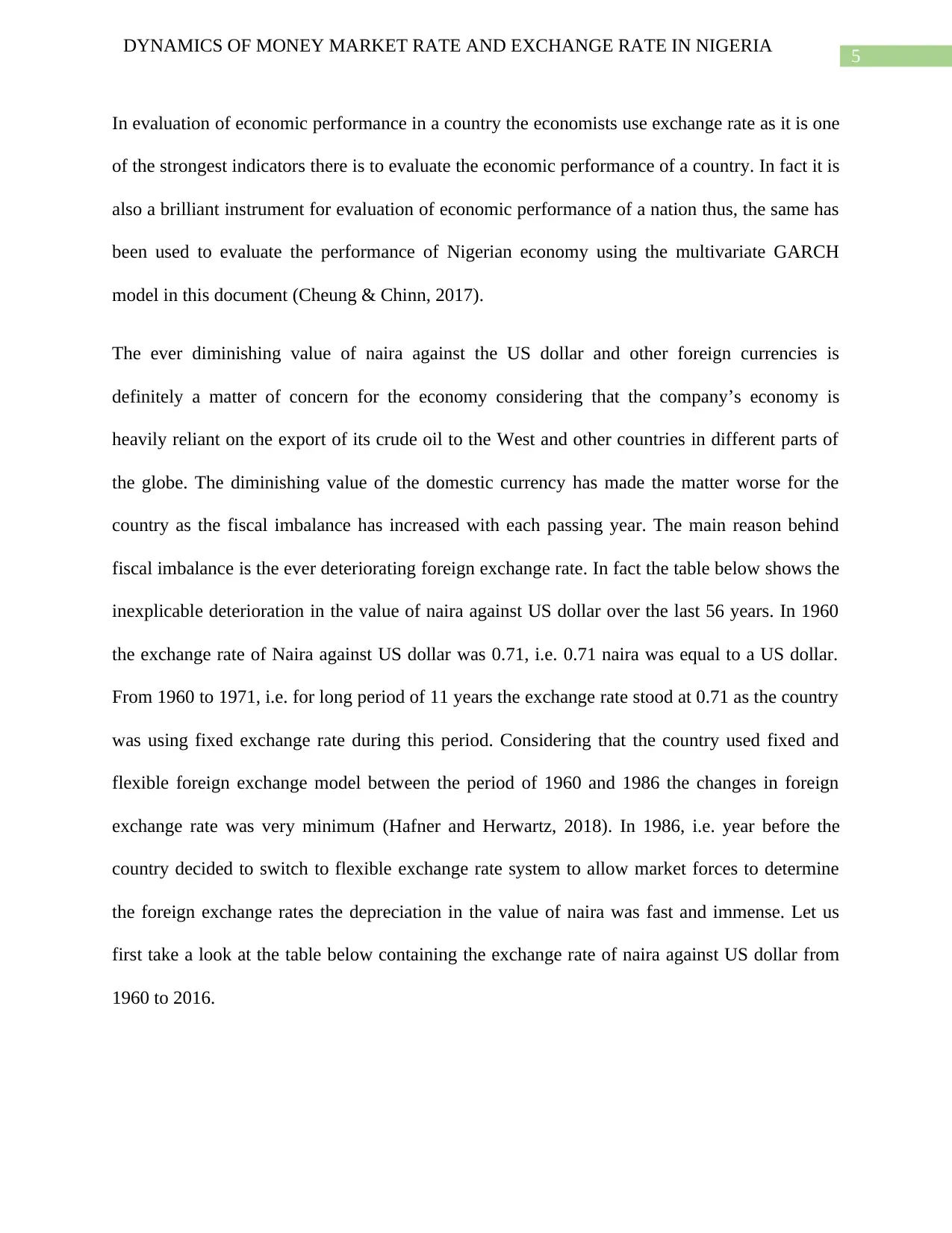
5
DYNAMICS OF MONEY MARKET RATE AND EXCHANGE RATE IN NIGERIA
In evaluation of economic performance in a country the economists use exchange rate as it is one
of the strongest indicators there is to evaluate the economic performance of a country. In fact it is
also a brilliant instrument for evaluation of economic performance of a nation thus, the same has
been used to evaluate the performance of Nigerian economy using the multivariate GARCH
model in this document (Cheung & Chinn, 2017).
The ever diminishing value of naira against the US dollar and other foreign currencies is
definitely a matter of concern for the economy considering that the company’s economy is
heavily reliant on the export of its crude oil to the West and other countries in different parts of
the globe. The diminishing value of the domestic currency has made the matter worse for the
country as the fiscal imbalance has increased with each passing year. The main reason behind
fiscal imbalance is the ever deteriorating foreign exchange rate. In fact the table below shows the
inexplicable deterioration in the value of naira against US dollar over the last 56 years. In 1960
the exchange rate of Naira against US dollar was 0.71, i.e. 0.71 naira was equal to a US dollar.
From 1960 to 1971, i.e. for long period of 11 years the exchange rate stood at 0.71 as the country
was using fixed exchange rate during this period. Considering that the country used fixed and
flexible foreign exchange model between the period of 1960 and 1986 the changes in foreign
exchange rate was very minimum (Hafner and Herwartz, 2018). In 1986, i.e. year before the
country decided to switch to flexible exchange rate system to allow market forces to determine
the foreign exchange rates the depreciation in the value of naira was fast and immense. Let us
first take a look at the table below containing the exchange rate of naira against US dollar from
1960 to 2016.
DYNAMICS OF MONEY MARKET RATE AND EXCHANGE RATE IN NIGERIA
In evaluation of economic performance in a country the economists use exchange rate as it is one
of the strongest indicators there is to evaluate the economic performance of a country. In fact it is
also a brilliant instrument for evaluation of economic performance of a nation thus, the same has
been used to evaluate the performance of Nigerian economy using the multivariate GARCH
model in this document (Cheung & Chinn, 2017).
The ever diminishing value of naira against the US dollar and other foreign currencies is
definitely a matter of concern for the economy considering that the company’s economy is
heavily reliant on the export of its crude oil to the West and other countries in different parts of
the globe. The diminishing value of the domestic currency has made the matter worse for the
country as the fiscal imbalance has increased with each passing year. The main reason behind
fiscal imbalance is the ever deteriorating foreign exchange rate. In fact the table below shows the
inexplicable deterioration in the value of naira against US dollar over the last 56 years. In 1960
the exchange rate of Naira against US dollar was 0.71, i.e. 0.71 naira was equal to a US dollar.
From 1960 to 1971, i.e. for long period of 11 years the exchange rate stood at 0.71 as the country
was using fixed exchange rate during this period. Considering that the country used fixed and
flexible foreign exchange model between the period of 1960 and 1986 the changes in foreign
exchange rate was very minimum (Hafner and Herwartz, 2018). In 1986, i.e. year before the
country decided to switch to flexible exchange rate system to allow market forces to determine
the foreign exchange rates the depreciation in the value of naira was fast and immense. Let us
first take a look at the table below containing the exchange rate of naira against US dollar from
1960 to 2016.
⊘ This is a preview!⊘
Do you want full access?
Subscribe today to unlock all pages.

Trusted by 1+ million students worldwide
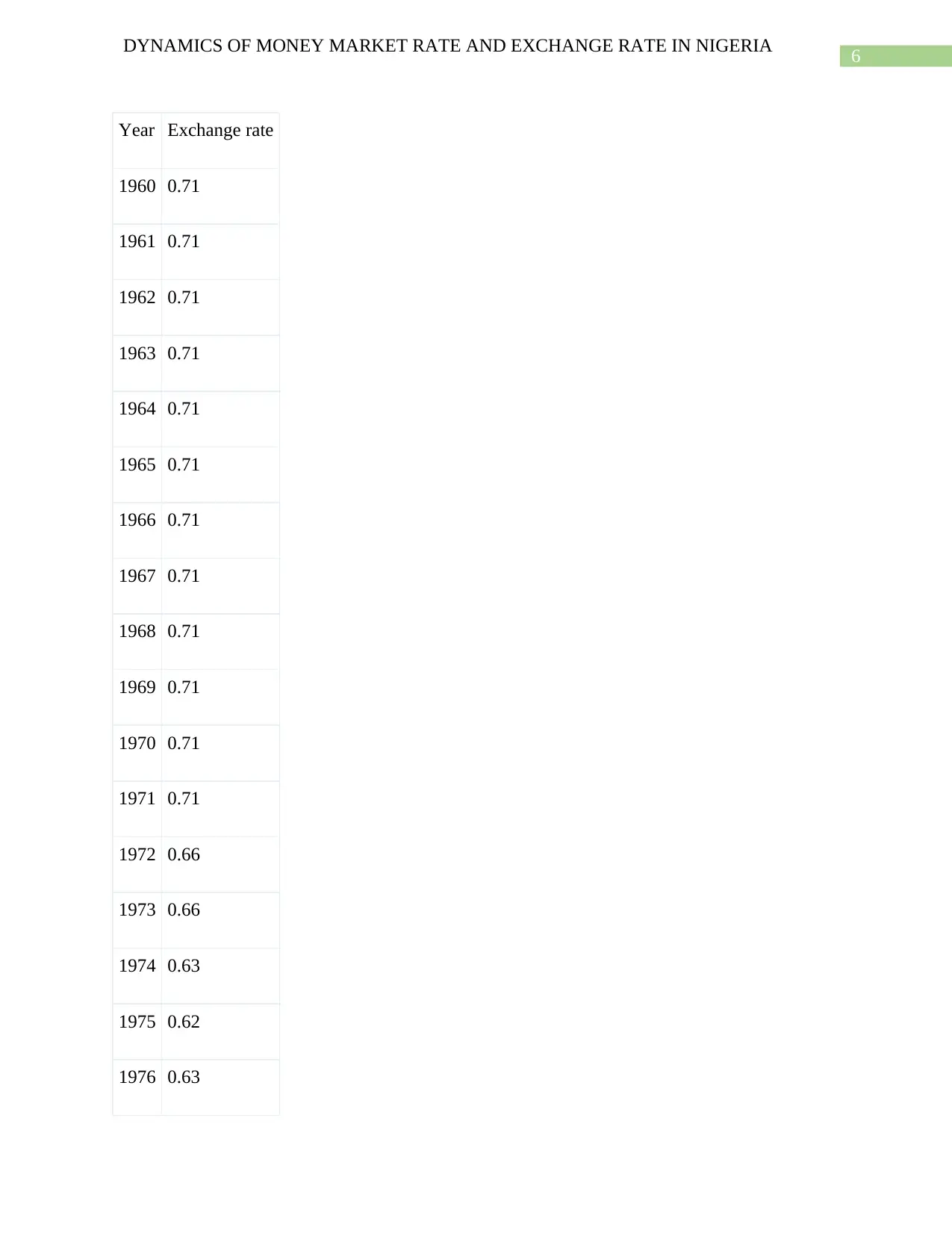
6
DYNAMICS OF MONEY MARKET RATE AND EXCHANGE RATE IN NIGERIA
Year Exchange rate
1960 0.71
1961 0.71
1962 0.71
1963 0.71
1964 0.71
1965 0.71
1966 0.71
1967 0.71
1968 0.71
1969 0.71
1970 0.71
1971 0.71
1972 0.66
1973 0.66
1974 0.63
1975 0.62
1976 0.63
DYNAMICS OF MONEY MARKET RATE AND EXCHANGE RATE IN NIGERIA
Year Exchange rate
1960 0.71
1961 0.71
1962 0.71
1963 0.71
1964 0.71
1965 0.71
1966 0.71
1967 0.71
1968 0.71
1969 0.71
1970 0.71
1971 0.71
1972 0.66
1973 0.66
1974 0.63
1975 0.62
1976 0.63
Paraphrase This Document
Need a fresh take? Get an instant paraphrase of this document with our AI Paraphraser
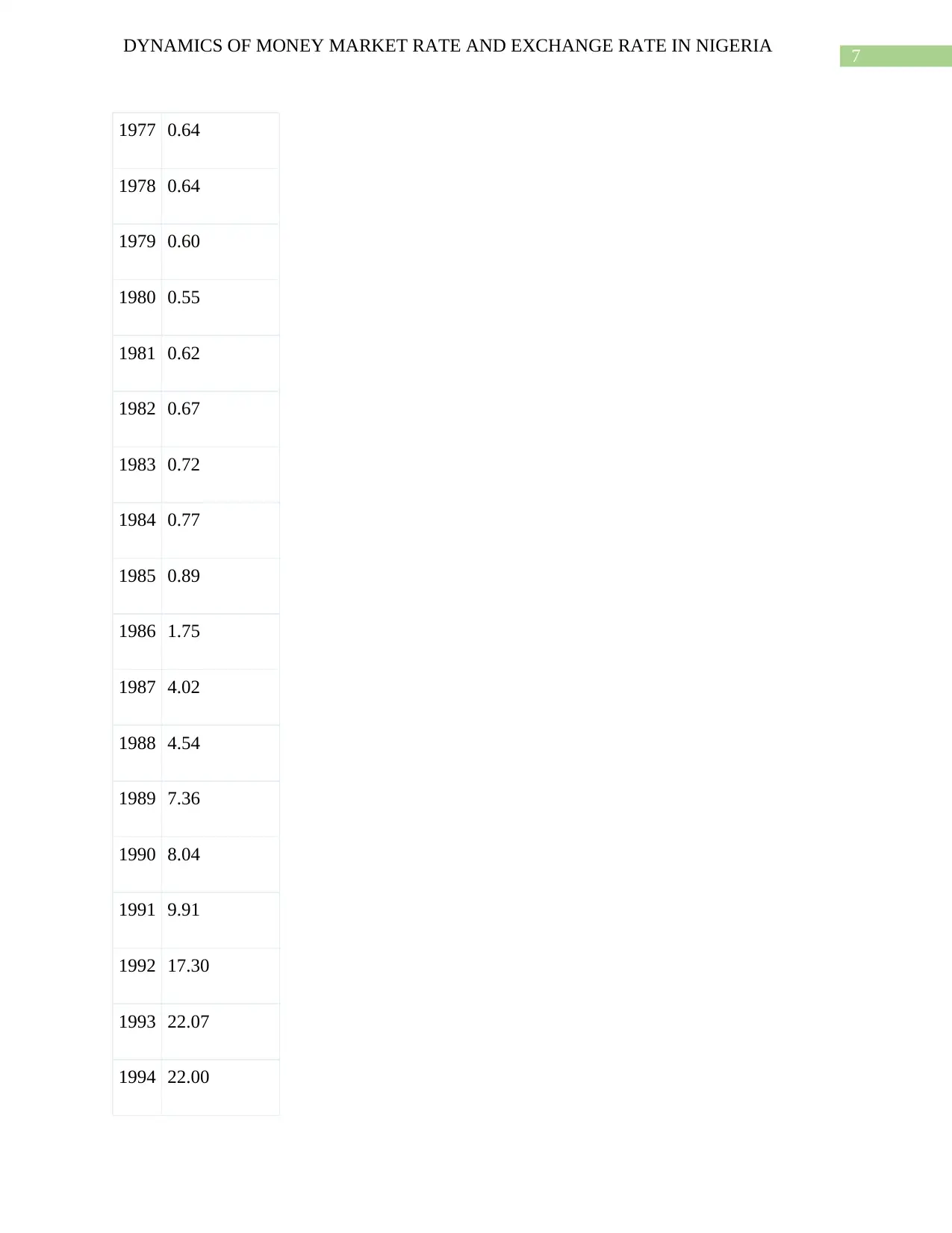
7
DYNAMICS OF MONEY MARKET RATE AND EXCHANGE RATE IN NIGERIA
1977 0.64
1978 0.64
1979 0.60
1980 0.55
1981 0.62
1982 0.67
1983 0.72
1984 0.77
1985 0.89
1986 1.75
1987 4.02
1988 4.54
1989 7.36
1990 8.04
1991 9.91
1992 17.30
1993 22.07
1994 22.00
DYNAMICS OF MONEY MARKET RATE AND EXCHANGE RATE IN NIGERIA
1977 0.64
1978 0.64
1979 0.60
1980 0.55
1981 0.62
1982 0.67
1983 0.72
1984 0.77
1985 0.89
1986 1.75
1987 4.02
1988 4.54
1989 7.36
1990 8.04
1991 9.91
1992 17.30
1993 22.07
1994 22.00
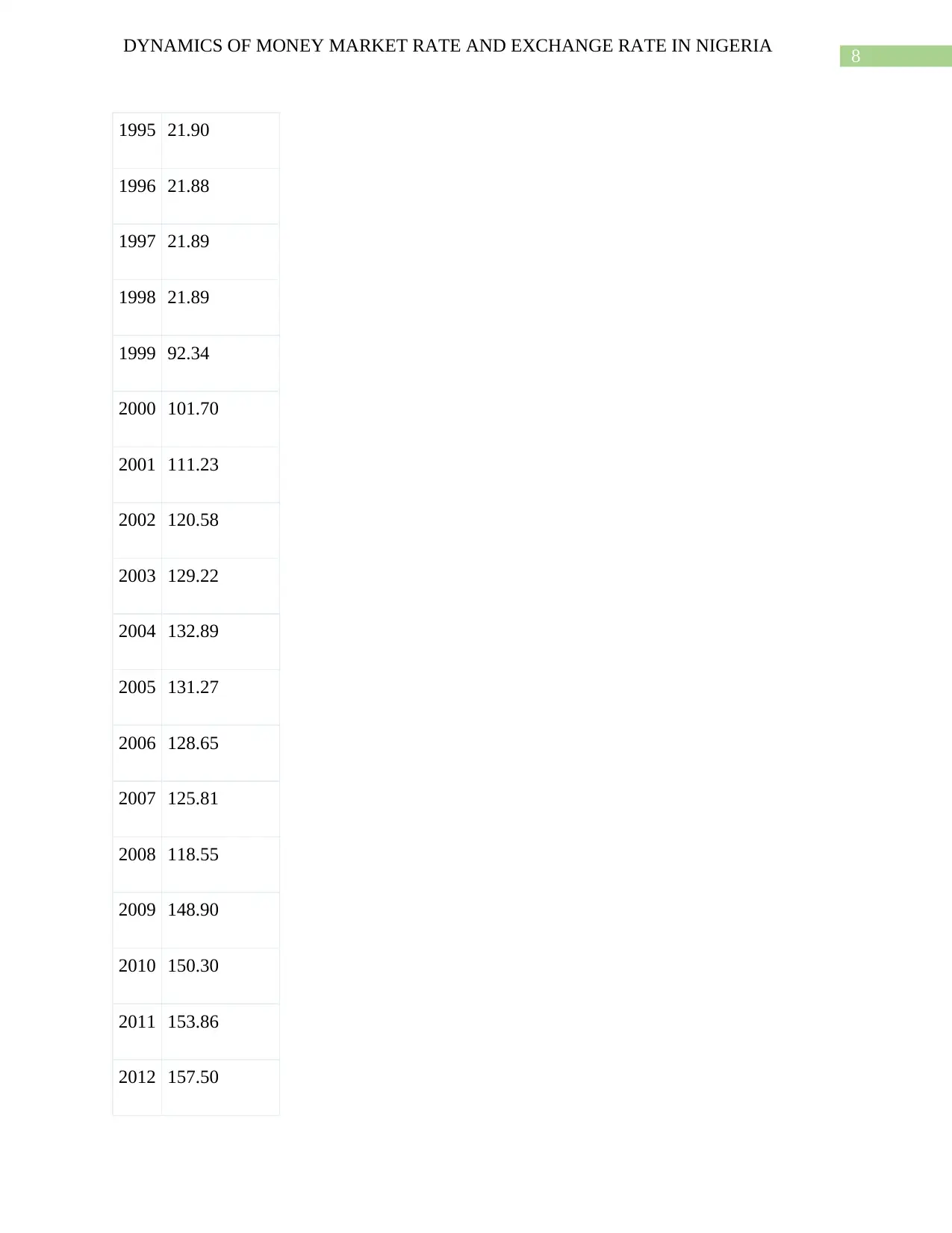
8
DYNAMICS OF MONEY MARKET RATE AND EXCHANGE RATE IN NIGERIA
1995 21.90
1996 21.88
1997 21.89
1998 21.89
1999 92.34
2000 101.70
2001 111.23
2002 120.58
2003 129.22
2004 132.89
2005 131.27
2006 128.65
2007 125.81
2008 118.55
2009 148.90
2010 150.30
2011 153.86
2012 157.50
DYNAMICS OF MONEY MARKET RATE AND EXCHANGE RATE IN NIGERIA
1995 21.90
1996 21.88
1997 21.89
1998 21.89
1999 92.34
2000 101.70
2001 111.23
2002 120.58
2003 129.22
2004 132.89
2005 131.27
2006 128.65
2007 125.81
2008 118.55
2009 148.90
2010 150.30
2011 153.86
2012 157.50
⊘ This is a preview!⊘
Do you want full access?
Subscribe today to unlock all pages.

Trusted by 1+ million students worldwide
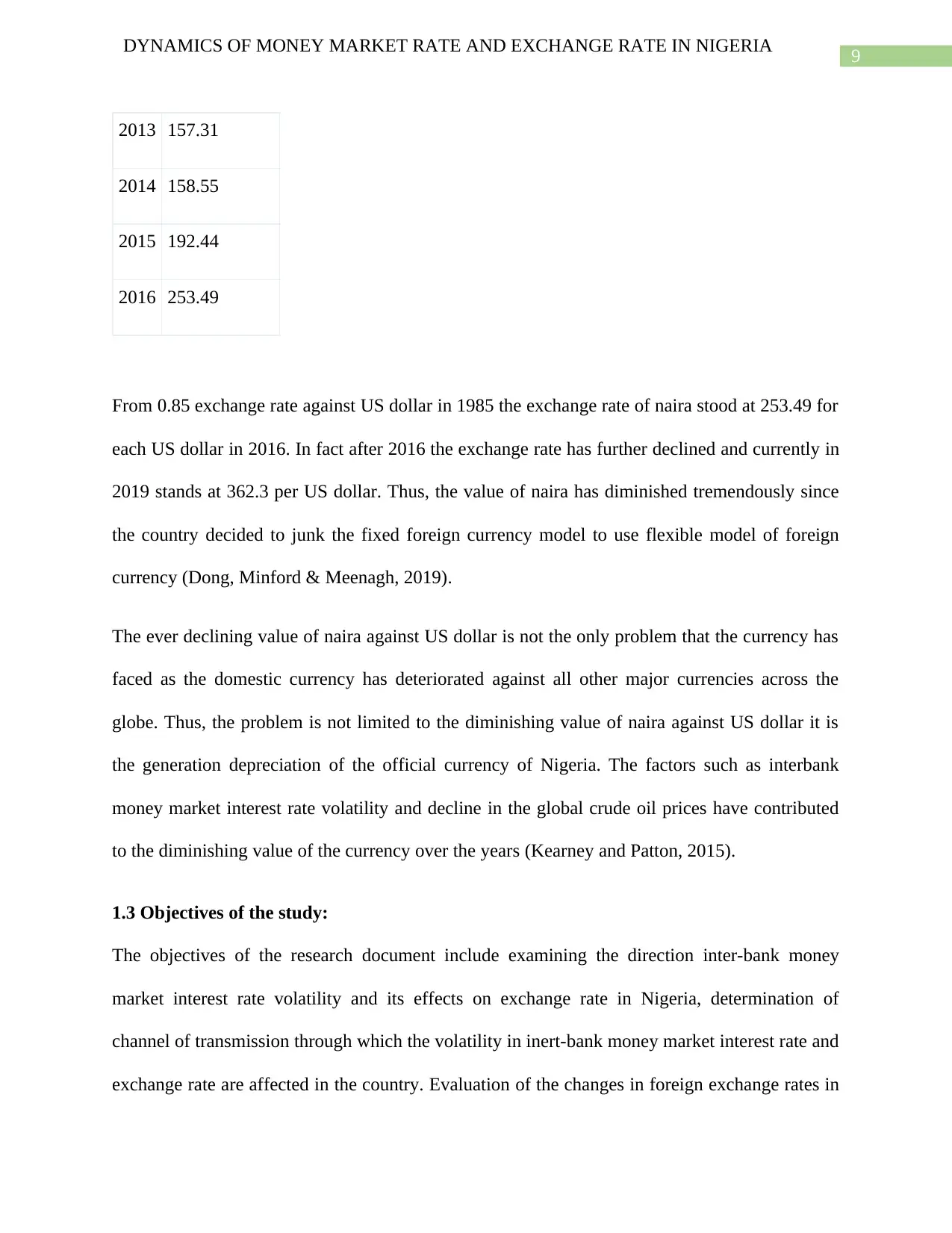
9
DYNAMICS OF MONEY MARKET RATE AND EXCHANGE RATE IN NIGERIA
2013 157.31
2014 158.55
2015 192.44
2016 253.49
From 0.85 exchange rate against US dollar in 1985 the exchange rate of naira stood at 253.49 for
each US dollar in 2016. In fact after 2016 the exchange rate has further declined and currently in
2019 stands at 362.3 per US dollar. Thus, the value of naira has diminished tremendously since
the country decided to junk the fixed foreign currency model to use flexible model of foreign
currency (Dong, Minford & Meenagh, 2019).
The ever declining value of naira against US dollar is not the only problem that the currency has
faced as the domestic currency has deteriorated against all other major currencies across the
globe. Thus, the problem is not limited to the diminishing value of naira against US dollar it is
the generation depreciation of the official currency of Nigeria. The factors such as interbank
money market interest rate volatility and decline in the global crude oil prices have contributed
to the diminishing value of the currency over the years (Kearney and Patton, 2015).
1.3 Objectives of the study:
The objectives of the research document include examining the direction inter-bank money
market interest rate volatility and its effects on exchange rate in Nigeria, determination of
channel of transmission through which the volatility in inert-bank money market interest rate and
exchange rate are affected in the country. Evaluation of the changes in foreign exchange rates in
DYNAMICS OF MONEY MARKET RATE AND EXCHANGE RATE IN NIGERIA
2013 157.31
2014 158.55
2015 192.44
2016 253.49
From 0.85 exchange rate against US dollar in 1985 the exchange rate of naira stood at 253.49 for
each US dollar in 2016. In fact after 2016 the exchange rate has further declined and currently in
2019 stands at 362.3 per US dollar. Thus, the value of naira has diminished tremendously since
the country decided to junk the fixed foreign currency model to use flexible model of foreign
currency (Dong, Minford & Meenagh, 2019).
The ever declining value of naira against US dollar is not the only problem that the currency has
faced as the domestic currency has deteriorated against all other major currencies across the
globe. Thus, the problem is not limited to the diminishing value of naira against US dollar it is
the generation depreciation of the official currency of Nigeria. The factors such as interbank
money market interest rate volatility and decline in the global crude oil prices have contributed
to the diminishing value of the currency over the years (Kearney and Patton, 2015).
1.3 Objectives of the study:
The objectives of the research document include examining the direction inter-bank money
market interest rate volatility and its effects on exchange rate in Nigeria, determination of
channel of transmission through which the volatility in inert-bank money market interest rate and
exchange rate are affected in the country. Evaluation of the changes in foreign exchange rates in
Paraphrase This Document
Need a fresh take? Get an instant paraphrase of this document with our AI Paraphraser
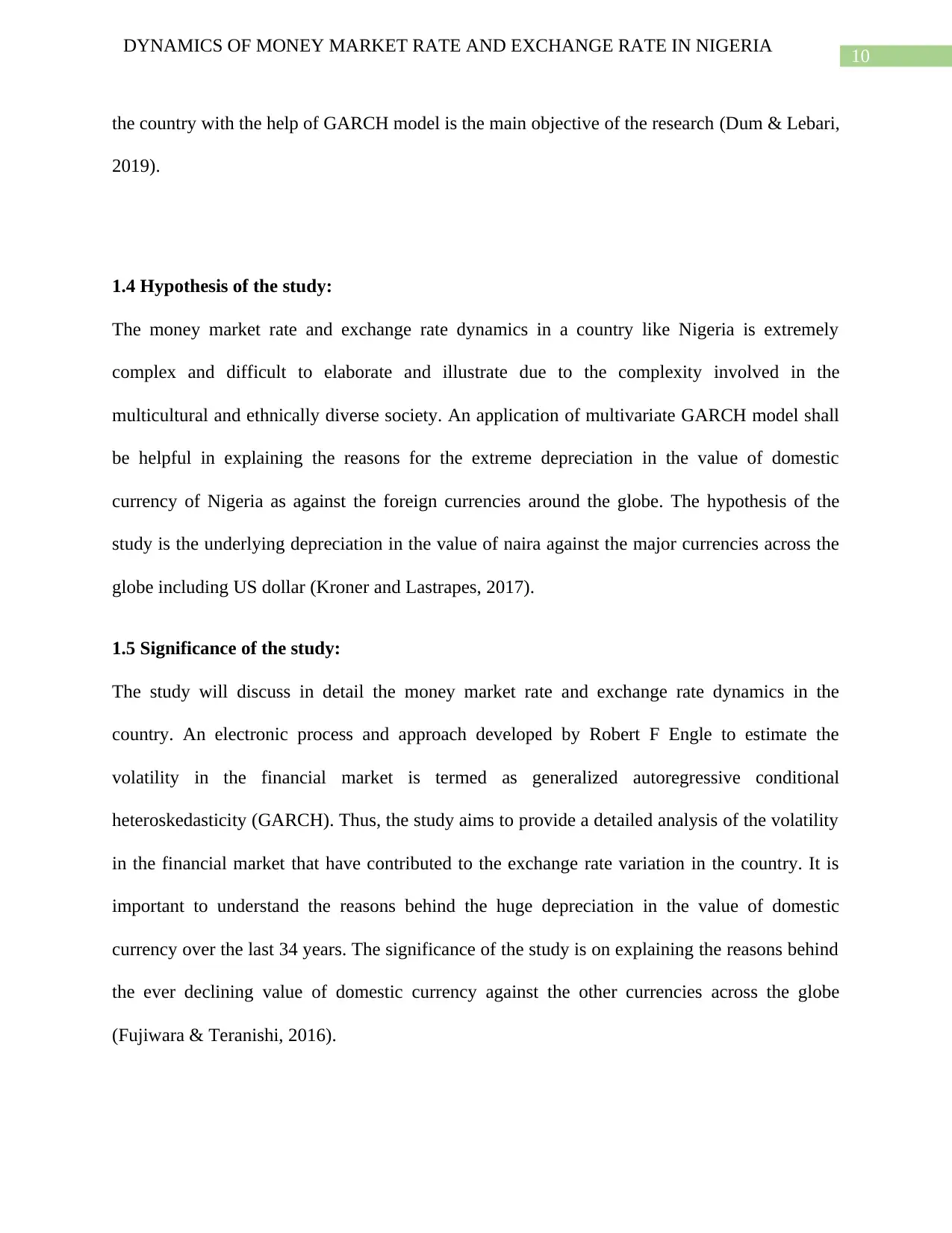
10
DYNAMICS OF MONEY MARKET RATE AND EXCHANGE RATE IN NIGERIA
the country with the help of GARCH model is the main objective of the research (Dum & Lebari,
2019).
1.4 Hypothesis of the study:
The money market rate and exchange rate dynamics in a country like Nigeria is extremely
complex and difficult to elaborate and illustrate due to the complexity involved in the
multicultural and ethnically diverse society. An application of multivariate GARCH model shall
be helpful in explaining the reasons for the extreme depreciation in the value of domestic
currency of Nigeria as against the foreign currencies around the globe. The hypothesis of the
study is the underlying depreciation in the value of naira against the major currencies across the
globe including US dollar (Kroner and Lastrapes, 2017).
1.5 Significance of the study:
The study will discuss in detail the money market rate and exchange rate dynamics in the
country. An electronic process and approach developed by Robert F Engle to estimate the
volatility in the financial market is termed as generalized autoregressive conditional
heteroskedasticity (GARCH). Thus, the study aims to provide a detailed analysis of the volatility
in the financial market that have contributed to the exchange rate variation in the country. It is
important to understand the reasons behind the huge depreciation in the value of domestic
currency over the last 34 years. The significance of the study is on explaining the reasons behind
the ever declining value of domestic currency against the other currencies across the globe
(Fujiwara & Teranishi, 2016).
DYNAMICS OF MONEY MARKET RATE AND EXCHANGE RATE IN NIGERIA
the country with the help of GARCH model is the main objective of the research (Dum & Lebari,
2019).
1.4 Hypothesis of the study:
The money market rate and exchange rate dynamics in a country like Nigeria is extremely
complex and difficult to elaborate and illustrate due to the complexity involved in the
multicultural and ethnically diverse society. An application of multivariate GARCH model shall
be helpful in explaining the reasons for the extreme depreciation in the value of domestic
currency of Nigeria as against the foreign currencies around the globe. The hypothesis of the
study is the underlying depreciation in the value of naira against the major currencies across the
globe including US dollar (Kroner and Lastrapes, 2017).
1.5 Significance of the study:
The study will discuss in detail the money market rate and exchange rate dynamics in the
country. An electronic process and approach developed by Robert F Engle to estimate the
volatility in the financial market is termed as generalized autoregressive conditional
heteroskedasticity (GARCH). Thus, the study aims to provide a detailed analysis of the volatility
in the financial market that have contributed to the exchange rate variation in the country. It is
important to understand the reasons behind the huge depreciation in the value of domestic
currency over the last 34 years. The significance of the study is on explaining the reasons behind
the ever declining value of domestic currency against the other currencies across the globe
(Fujiwara & Teranishi, 2016).
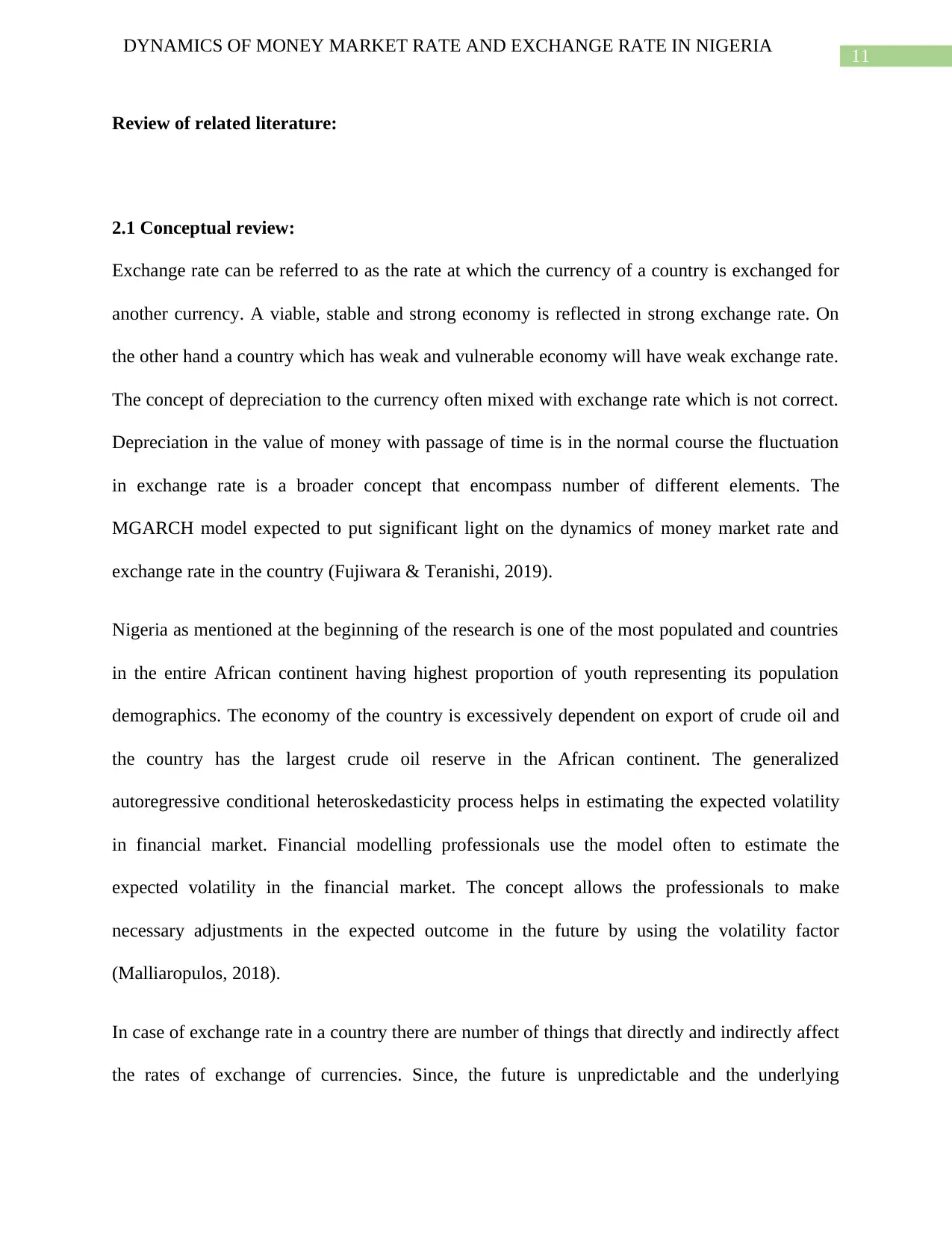
11
DYNAMICS OF MONEY MARKET RATE AND EXCHANGE RATE IN NIGERIA
Review of related literature:
2.1 Conceptual review:
Exchange rate can be referred to as the rate at which the currency of a country is exchanged for
another currency. A viable, stable and strong economy is reflected in strong exchange rate. On
the other hand a country which has weak and vulnerable economy will have weak exchange rate.
The concept of depreciation to the currency often mixed with exchange rate which is not correct.
Depreciation in the value of money with passage of time is in the normal course the fluctuation
in exchange rate is a broader concept that encompass number of different elements. The
MGARCH model expected to put significant light on the dynamics of money market rate and
exchange rate in the country (Fujiwara & Teranishi, 2019).
Nigeria as mentioned at the beginning of the research is one of the most populated and countries
in the entire African continent having highest proportion of youth representing its population
demographics. The economy of the country is excessively dependent on export of crude oil and
the country has the largest crude oil reserve in the African continent. The generalized
autoregressive conditional heteroskedasticity process helps in estimating the expected volatility
in financial market. Financial modelling professionals use the model often to estimate the
expected volatility in the financial market. The concept allows the professionals to make
necessary adjustments in the expected outcome in the future by using the volatility factor
(Malliaropulos, 2018).
In case of exchange rate in a country there are number of things that directly and indirectly affect
the rates of exchange of currencies. Since, the future is unpredictable and the underlying
DYNAMICS OF MONEY MARKET RATE AND EXCHANGE RATE IN NIGERIA
Review of related literature:
2.1 Conceptual review:
Exchange rate can be referred to as the rate at which the currency of a country is exchanged for
another currency. A viable, stable and strong economy is reflected in strong exchange rate. On
the other hand a country which has weak and vulnerable economy will have weak exchange rate.
The concept of depreciation to the currency often mixed with exchange rate which is not correct.
Depreciation in the value of money with passage of time is in the normal course the fluctuation
in exchange rate is a broader concept that encompass number of different elements. The
MGARCH model expected to put significant light on the dynamics of money market rate and
exchange rate in the country (Fujiwara & Teranishi, 2019).
Nigeria as mentioned at the beginning of the research is one of the most populated and countries
in the entire African continent having highest proportion of youth representing its population
demographics. The economy of the country is excessively dependent on export of crude oil and
the country has the largest crude oil reserve in the African continent. The generalized
autoregressive conditional heteroskedasticity process helps in estimating the expected volatility
in financial market. Financial modelling professionals use the model often to estimate the
expected volatility in the financial market. The concept allows the professionals to make
necessary adjustments in the expected outcome in the future by using the volatility factor
(Malliaropulos, 2018).
In case of exchange rate in a country there are number of things that directly and indirectly affect
the rates of exchange of currencies. Since, the future is unpredictable and the underlying
⊘ This is a preview!⊘
Do you want full access?
Subscribe today to unlock all pages.

Trusted by 1+ million students worldwide
1 out of 49
Related Documents
Your All-in-One AI-Powered Toolkit for Academic Success.
+13062052269
info@desklib.com
Available 24*7 on WhatsApp / Email
![[object Object]](/_next/static/media/star-bottom.7253800d.svg)
Unlock your academic potential
Copyright © 2020–2025 A2Z Services. All Rights Reserved. Developed and managed by ZUCOL.





